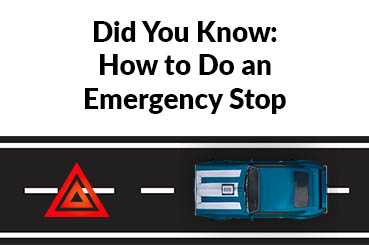Embarking on the journey of learning to drive encompasses far more than simply grasping the mechanics of a vehicle. It delves into the realm of road safety, where mastery of critical manoeuvres like the emergency stop becomes paramount.
In this comprehensive guide, we’ll explore the nuances of executing an emergency stop, a fundamental skill that not only determines driving test success but, more crucially, ensures the safety of oneself and fellow road users.
From understanding the essence of an emergency stop to mastering its execution in varying situations, this guide aims to equip drivers, especially beginners, with the knowledge and confidence to navigate unforeseen circumstances on the road.
Join us on this journey as we unravel the intricacies of this essential driving skill, aiming not just to pass tests but to uphold safety and responsibility behind the wheel.

What is an Emergency Stop?
An emergency stop is a sudden, forceful application of brakes to halt a vehicle swiftly in response to an unexpected or hazardous situation. It involves pressing the brake pedal firmly and decisively, bringing the vehicle to a controlled standstill.
In the context of driving safety, this manoeuvre is pivotal. It’s not just about stopping abruptly but doing so in a manner that ensures the safety of everyone involved.
What is an Emergency Stop Signal?
The emergency stop signal is a way to communicate to drivers behind that a vehicle has suddenly decelerated. This signal alerts them to the abrupt change in speed and helps prevent potential collisions.
Typically, it involves engaging hazard lights or specific brake light patterns to indicate an emergency stop.

Beginners Guide to Emergency Stop
For beginners, learning the emergency stop is a critical skill. Learning how to execute an emergency stop encompasses a blend of crucial elements integral to safe driving practices.
When faced with an unexpected hazard, the first step is to firmly apply pressure to the brake pedal while maintaining a steady grip on the steering wheel. Understanding the steering wheel’s role in this manoeuvre ensures control over the vehicle’s direction during the abrupt halt.
Moreover, comprehending stopping distances, influenced by speed limits and road conditions, aids in gauging the required braking force.
Awareness of the anti-lock braking system (ABS) is also vital; this system prevents wheels from locking up during emergency braking, allowing drivers to maintain steering control while reducing stopping distances.
Mastering these aspects ensures that an emergency stop is executed efficiently, minimising the risk of collisions and highlighting the significance of these skills in safe driving practices.
How to Do an Emergency Stop in Automatic Car

Mastering an emergency stop in an automatic car demands a nuanced understanding of the vehicle’s transmission system. When initiating an emergency stop in an automatic car, the primary step involves firmly pressing the brake pedal. Unlike manual transmission vehicles where shifting gears is pivotal, in an emergency stop with an automatic car, the focus is on decisive braking.
Drivers must maintain firm and steady pressure on the brake pedal to prompt the automatic transmission system to smoothly downshift and bring the vehicle to a controlled stop. This skill requires familiarity with the automatic transmission’s response to sudden braking, ensuring a swift but controlled halt in emergency situations, underscoring the importance of adapting emergency stop techniques to different vehicle types, including emergency stop automatic car scenarios.
Emergency Stop on Driving Test
The emergency stop segment during a driving test in the UK holds pivotal significance, assessing a candidate’s ability to swiftly and safely execute this crucial manoeuvre. The evaluation of an emergency stop driving test scrutinises a candidate’s capacity to respond promptly to the examiner’s signal, demonstrating adept control and adherence to road safety protocols.
Candidates must showcase not just the technical prowess in applying brakes but also the finesse in bringing the vehicle to a controlled stop without compromising the safety of themselves or other road users. Mastery of this aspect is essential to successfully pass the driving test, cementing the importance of this skill within the framework of road safety assessments.
Is Emergency Stop Still in Driving Test?
Yes, the emergency stop remains a vital part of driving tests in the UK and many other regions. It showcases a driver’s capability to react swiftly and bring the vehicle to a controlled stop in unexpected situations.
Mastering the emergency stop is not merely a requisite for passing a driving test; it’s a fundamental skill contributing to road safety.
Knowing how to execute this manoeuvre ensures drivers can respond swiftly and decisively to unforeseen circumstances, averting potential accidents and upholding safety for all road users.




